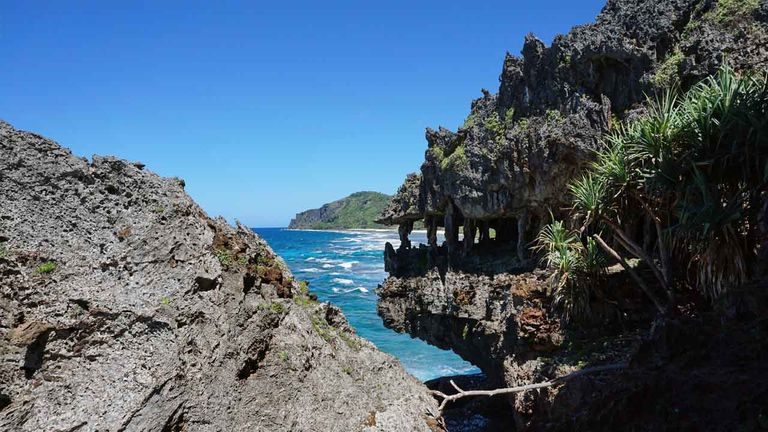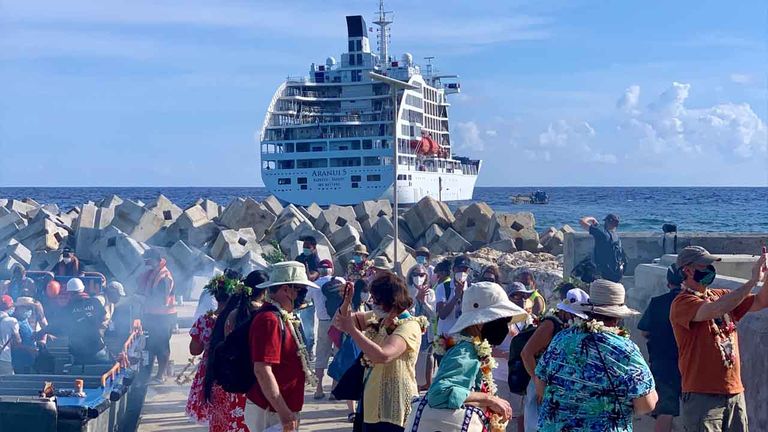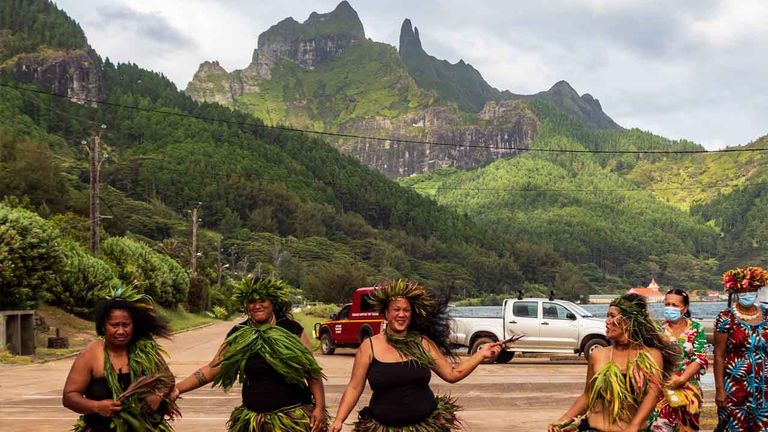For 40 years, Aranui Cruises has been operating yeoman service between Tahiti and the Marquesas Islands using a combination freighter/cruise ship. This year, in response to requests from repeat guests for more varied itineraries, they added a cruise to the Austral Islands onboard the Aranui 5, which entered service in 2015.
On this voyage, the ship is not carrying any cargo — except for some emergency supplies bound for Raiatea, allowed by special exception — because the company’s cargo license is only good for the Marquesas. (French Polynesia establishes limited cargo licenses to specific island groups to ensure economic stability and maintain continuity of service.)
The cargo and passenger areas are separated, so on my sailing, I enjoyed luxury comforts, but did notice cranes at the front of the ship, and a bit more movement while under way (as the positioning of the cargo compartments prevents the addition of stabilizers).
The Austral Islands Itinerary Onboard Aranui 5
Per the itinerary, Aranui 5 calls on Raiatea, in the Society Islands, before heading to the Austral Island group to the south, after a day crossing some of the world’s loneliest stretches of ocean.
The islands straddle the southern Tropic of Capricorn and are more temperate than their northern counterparts, and we visited all five: Rurutu, Rimatara, Tubuai, Raivavae and distant Rapa. Aranui 5 also stopped at the atoll of Anaa, in the Tuamotus, before returning to Tahiti.
The Australs are sparsely populated and seldom visited by tourists. There are airports (except at Rapa) but service from Tahiti isn’t offered daily. There are no resorts, only Tahitian guesthouses called pensions, and the small communities are tight-knit and somewhat conservative. At one island, a cooler of beer brought onshore by the Aranui staff to serve with lunch was taken back onboard after the mayor objected.
Caves and Coffee in Rurutu
Rurutu really brought the dazzle. At most ports without wharves, Aranui 5 anchors offshore and passengers are shuttled ashore in barges that resemble WWII-era landing craft, complete with front ends that lower onto a beach. At Rurutu, the barges disembark at a small wharf, where we were greeted with a woven pandanus arch with the words “manava” (welcome) lovingly spelled out in masking tape.
The next stop was the mairie, or town hall, where we were greeted with dancers and rows of women in colorful dresses giving out fragrant hei garlands of tiare blossoms, leaves, fruit and other plant trimmings. It was touching to think about the amount of effort the community must have put into making them for the more than 200 passengers and crew. We were then treated to music and dancing in the courtyard, along with a demonstration of stone-lifting, a traditional display-of-strength sport in this area.
 Rurutu is known for its cave.
Rurutu is known for its cave.
Credit: 2022 damedias/stock.adobe.com
Next, it was off to a local coffee plantation, where coffee beans dry on racks and women in flower crowns pack bags of ground coffee by hand. Next, we headed to Ana a’eo Cave, a magnificent grotto also informally known by locals as the “Mitterrand Cave” since the visit of French President Francois Mitterrand in 1990.
The cave was impressive from the outside, and our guides told us how the caves were used for important religious and cultural rituals before European contact, including ritual cannibalism, which Polynesians on the island would do to acquire the mana, or life force, of the enemies they had vanquished in battle.
"But do not be alarmed,” the guide said with a smile. “We have already prepared lunch today.”
At that point, a great cry went up from inside the cave and the sounds of drums began to echo through the chamber. Upon entering, we discovered a band of musicians and dancers had been hiding in the cave, waiting to welcome the visitors with more song and dance, made even more stunning by the play of light and shadows off the stalagmites of the grotto.
After that, we were off to take in several scenic vistas, see a demonstration of taro planting and stop into the mayor’s house for a lunch of traditional foods including roasted taro, cooked and raw fish, fresh fruit, lemonade, coconuts and a variety of starchy desserts made with manioc flour. After lunch, there was time for swimming at the beach.
Birding in Rimatara
At our next stop, Rimatara, I couldn’t pass up the chance to see the rare Kuhl’s lorikeet (known locally as the ‘Ura de Rimatara), which only lives on that island.
 In Rimatara, cruisers were greeted with a cleansing.
In Rimatara, cruisers were greeted with a cleansing.
Credit: 2022 Scott LairdWe spent the morning hiking up the side of a tree-shaded hill (plucking grapefruit and guava from the trees for refreshment) to catch a glimpse of the colorful red-, blue- and green-shaded bird, and we weren’t disappointed. ‘Ura de Rimatara is an emblem of the island — it was also painted on the well-loved school buses that were used to transport us around the island, where we also saw the graves of the last royals of Rimatara, which was the final island in French Polynesia to be formally annexed by France in 1901.
A Comparison of Austral Islands and Ports
Every island stop had similarities and differences. At each, we were welcomed with flowers, singing and dancing. The Australs are also known for the quality of their woven goods, so there were baskets, hats, fans and colorful shell trinkets for sale at each port.
Raivavae was the only stop without a wharf, so we used the drawbridge front of the barges to disembark onto the beach. At Rimatara, we walked through a cloud of purifying smoke during our welcome. On Tubuai, we received open-ended hei and were treated to ice-cold coconuts and a massive fruit display at an impromptu craft fair at the mairie.
On Rapa, COVID-19 concerns kept the village sequestered from visitors, so the village came to the wharf for dancing, a demonstration of taro pounding and a lavish lunch after a hike up the mountain ridge to see the remains of one of several pre-European-contact-era fortifications dotting the island.
 Welcome dancers in Rapa
Welcome dancers in Rapa
Credit: 2022 Scott LairdEach island also had its own distinctive attraction. On Tubuai, it was the site of Fort George, built by the Bounty mutineers on their brief attempt to set up shop on the island. On Raivavae — which has rocky peaks and a gorgeous lagoon reminiscent of Bora Bora — it was Motu Piscine, a part of the lagoon that’s tranquil like a swimming pool, and the ruins of a pair of marae (a Polynesian temple) deep in the forest.
On Rapa, it was the distinctive language and dance traditions that are set apart even from the rest of the Australs. Rapa is the furthest south, with terrain and fauna more akin to New Zealand than Tahiti. Here, the greeting “Ia Orana” of Tahiti and “Ia Ogana” in some parts of the Australs becomes “Aronga.” There’s no airport, so the arrival of Aranui 5 was an event of even greater magnitude on this isolated island — sailing further south, the next land mass is Antarctica.
Context for cultural traditions in the Australs was given in a series of three lectures by ethnologist Josiane Di Giorgio on sea days during the voyage. Di Giorgio, who is from Tahiti and spent significant amounts of time on many of the Australs, including Rapa, shared fascinating academic insights into the history and cultural evolution of the islands.
What to Know About Sailing With Aranui Cruises
Aranui includes basic shore excursions at each stop on the itinerary, and to save time, the tours are often split between English and French-speaking groups. Additional excursions (including PADI dives, snorkeling and beach trips) are available for a nominal fee.
My premium suite had a sitting area and a balcony, as well as a mini fridge stocked with water and juice, a safe, and a fresh fruit display. Bathrooms are generously sized, and bath amenities incorporate local monoi oil.
Aranui’s next Austral Islands sailing is currently scheduled for September 2023, during the peak of the whale-watching season. Other itineraries include sailings to the remote Gambier Island group, with stops at Pitcairn Island, the home of the Bounty mutineers. A new passenger-only ship is slated to join the fleet in 2026 and will be dedicated to these new non-Marquesas itineraries.
Overall, the voyage almost felt like a journey into the past, to a place where the tourism industry is still largely nascent, with warm, genuine welcomes and fond, heartfelt farewells.